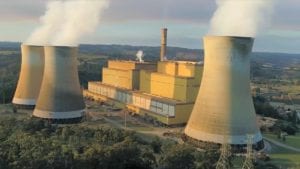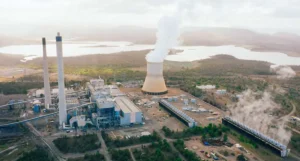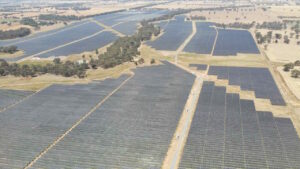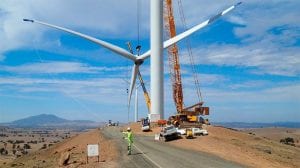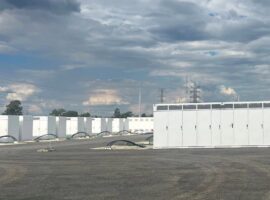AGL Energy says the creation new energy hubs, built around big batteries and green industrial precincts at its major fossil fuel assets, along with Victoria’s new mandate for massive offshore wind projects, could accelerate the closure of its remaining coal generators.
In an interview with RenewEconomy, chief operating officer Markus Brokhof says the Bayswater plant could be closed by 2030, and Loy Yang A by 2040 if the new energy hubs were built, if the planned offshore wind investment was delivered, and if NSW succeeded in its renewable infrastructure plan.
AGL is the largest coal generator in Australia, which also makes it the country’s biggest climate polluter, and is under intense pressure from activists, shareholders, and corporate bidders such as tech billionaire Mike Cannon-Brookes and Canada’s Brookfield to fast track its exit from coal.
The future of coal and the pace of the green energy transition in Australia remains a divisive political, regulatory, and market issue. And AGL finds itself in the middle of these forces, unsure how to both embrace change and protect its legacy assets, so it has decided to split itself in two to navigate the changes.
Cannon-Brookes and Brookfield charted a new frontier in activist investment strategies, lobbing an $8 billion plus bid for AGL last month, arguing that the demerger was a bad idea and all efforts should be made to close the remaining coal generators as soon as possible.
AGL rejected the original and a raised offer, and the bidders have now “downed pens” and seemingly walked away. AGL is now seeking shareholder approval for the demerger, and the creation of the new energy hubs are a major selling point of its transition plans.
Liddell in the Hunter Valley is being wound down and will close in early 2023, and AGL recently nudged forward the likely closure dates of the neighbouring Bayswater plant to 2033, and the Loy Yang A brown coal generator in Victoria to 2045.
Neither of these closure scenarios, however, are compatible to international climate targets, the NSW renewable infrastructure plan, or even the Australian Energy Market Operator’s planning blueprint, known as the Integrated System Plan.
But Brokhof says AGL could move the closures to the front end of its “closure window”, which in the case of Bayswater means 2030, and in the case of Loy Yang A to 2040, if certain things happen.
One is the delivery of Victoria’s newly announced offshore wind target, which aims to have at least 2GW of the new technology operating by 2032, and 9GW by 2040. “If that materialises we could move (Loy Yang A) to the front end of the closure window to 2040,” Brokhof told RenewEconomy.
The other is the delivery of the NSW infrastructure plan, which is looking at the creation of at least five renewable energy zones, new transmission, and up to 12GW of new renewables and storage.
“If new transmission … the renewables and the firming capacity, according to the New South Wales Government plan, is in action by 2030, then I think AGL will be willing to move (the Bayswater closure) to the front end of the window to 2030.”
The third element for AGL – and its contested plan to split its assets into two – is the creation of new green energy hubs at the principal fossil fuel sites at Liddell, Torrens Island (where AGL owns some ageing gas generators),and Loy Yang, which will be owned by the newly created Accel.
Brokhof – who outlined the plan at an energy and storage conference in Sydney on Wednesday – says the challenge for AGL is to recreate the revenue and profit flows it currently extracts from its fossil fuel fleet at these locations.
The plan is to build big batteries at each of these energy hubs – Torrens Island has already begun construction and Liddell now has planning approval. They will likely start with one or two hours storage, before being expanded to four hours. And AGL says batteries could be scaled to longer storage.
Around the new big batteries, the infrastructure and available land at these centres will be used to create hubs that could feature solar storage, green hydrogen, and industrial precincts that would consumer this heat and power.
AGL has already struck an MoU with Andrew Forrest’s ambitious Fortescue Future Industries for Liddell, and it expects to roll out agreements with other customers and partners in coming weeks.
“I think we are progressing now on an accelerated path,” Brokhof said, noting that there could also be new projects, beyond what is known at the moment, to help AGL recreate the revenues it current gets from coal powered generation.
The Liddell hub will also involve investments in the Bowmans Creek wind farm, the Bells Mountain pumped hydro project, and RayGen’s innovative solar-hydro technology that could deliver long term storage.
A 3MWh plant in Victoria is about to begin operating as a pilot, and if successful, could lead to a 100MWh project at Liddell.
At Torrens Island, AGL is looking at carbon capture technology from Air Liquide as well as expanding its battery offering (up to four hours) and fast start gas generators, while the focus at Loy Yang will be on hydrogen, low carbon metals and chemicals, firming and data centres.
Brokhof says these hubs will also serve as a focus, and a market, for the new fund it plans to create to support $4 billion of investment in new renewables and firming capacity.
Some of these investments will include Bowmans and Bells Mountain, but also the proposed Broken Hill battery, and other wind projects in Victoria and NSW.
Brokhof says the new energy hubs will be typical of a new energy system that moves away from huge, centralised “baseload” generators, to distributed systems that focus on “dispatchable” capacity, adaptive load, smaller generators and a series of micro-grids.



